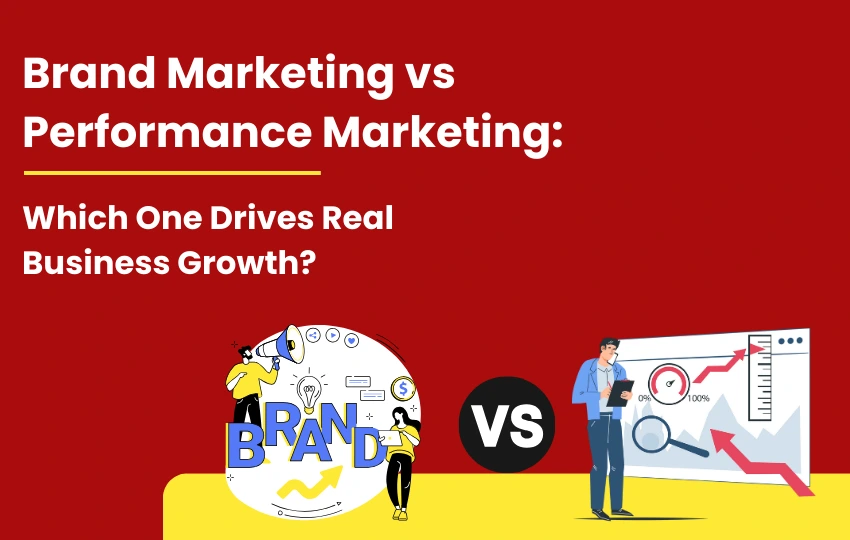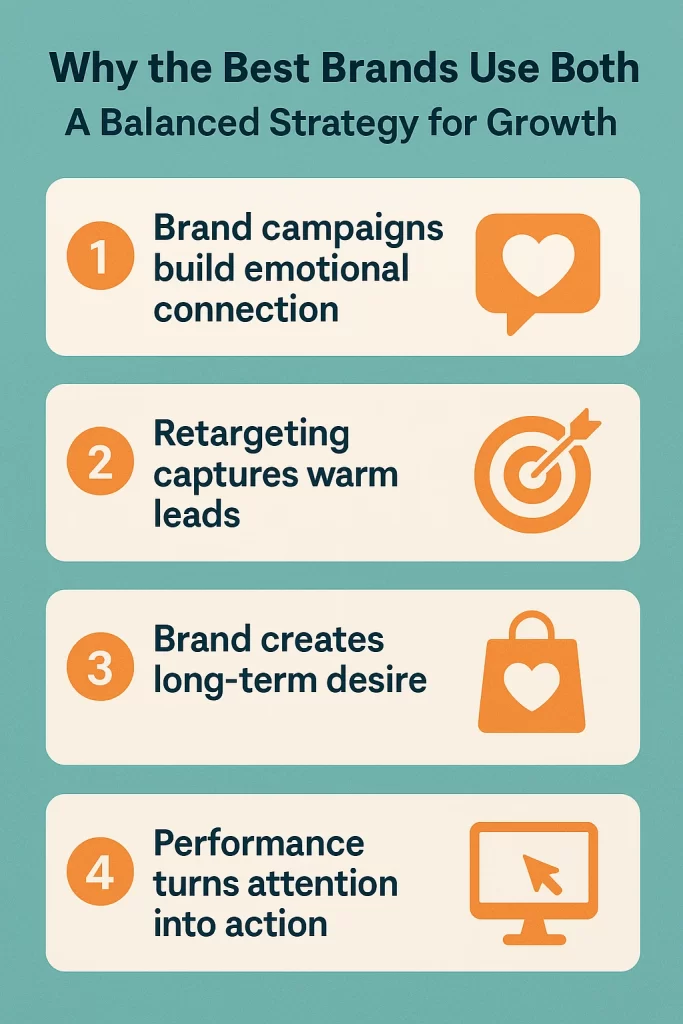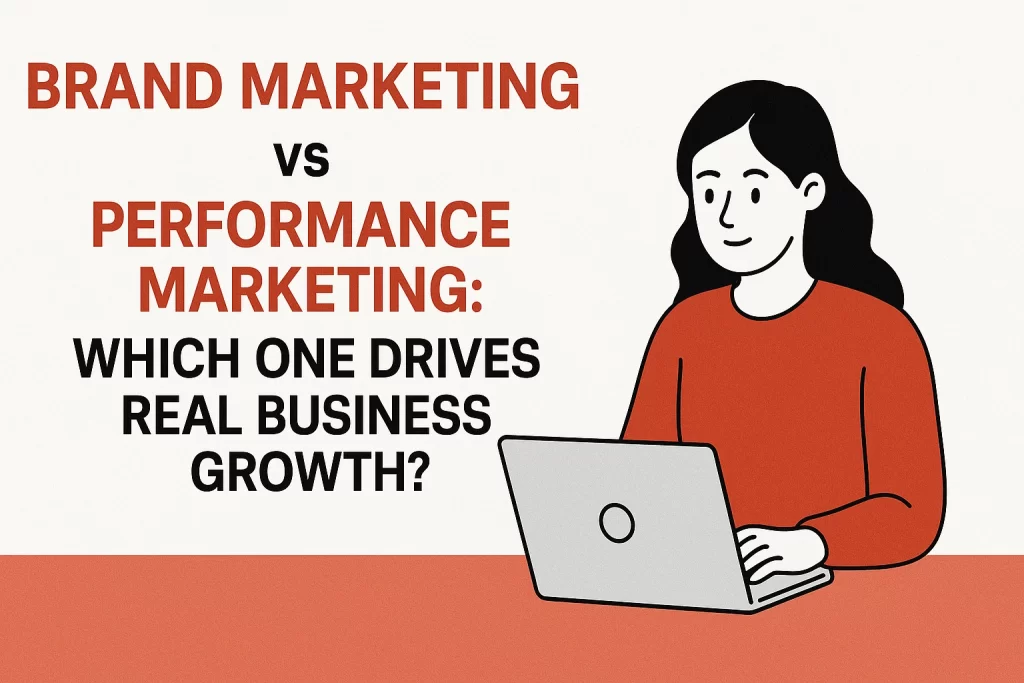
Brand Marketing vs Performance Marketing: Which One Drives Real Business Growth?
If you’re a business owner or startup founder, you’ve probably asked yourself: “Should I invest in brand marketing or performance marketing?” It’s a great question — and you’re not alone.
Marketing today feels like a tug of war. On one side, people say “branding builds trust and legacy.” On the other, some shout “Performance gets quick results and ROI!” So, who’s right? Where should your money go?
Relax. We’re going to break it all down in simple, friendly language. Like a conversation over coffee. By the end, you’ll know exactly when to use each one, what to expect, and how to combine both for maximum growth.
Let’s dive in.
Brand marketing is like planting a tree. It takes time, care, and patience. You’re not expecting fruit tomorrow — but someday, it will give you shade, trust, and loyalty. This kind of marketing focuses on who you are, what you stand for, and why people should remember you. Think Apple, Tata, or Nike. People don’t just buy their products; they buy the feeling, the story, the trust.
Brand marketing includes emotional storytelling, YouTube videos, influencer campaigns, and even the tone of your Instagram captions. It doesn’t scream “Buy Now!” Instead, it whispers, “Remember me.”
On the other side, performance marketing is about immediate action. You run a Facebook ad, get clicks, and boom — sales start coming in. It’s direct, trackable, and all about numbers. You want fast results? Performance marketing is your tool. You can track every rupee spent, how many leads you got, and what your return on investment was.
In short: brand builds relationships; performance drives sales.
Where Should You Invest First — Brand or Performance?
If you’re just starting out and your budget is tight, go with performance marketing. It’s the fastest way to see some action. You can run Google search ads, test Meta ads for quick traffic, or do retargeting to warm up interested users. Think of it like renting a house — you move in fast, and it gets the job done.
But if you’re already somewhat established and want to go big in the long run, branding is key. It’s like building your own home. It takes time and effort, but the foundation it lays is solid. Smart businesses start with performance and slowly add brand marketing to the mix. That way, they get immediate results while also building a strong future.
Performance vs Brand Marketing: How They Impact ROI Differently
Let’s talk about ROI — Return on Investment. It matters to everyone, right?
Performance marketing gives you quick, visible returns. You can literally see what you spend and what you earn. Spend ₹10,000 on Meta ads, and you can track how many leads or sales you got. It’s great for short-term campaigns, product launches, or when you need immediate results.
Brand marketing, on the other hand, is slower. But it builds something powerful: reputation and trust. Months down the line, people remember your name. They choose you over others. They trust you without needing to see an ad. That’s the long-term ROI. It’s not instant, but it compounds over time.
So here’s the deal: for fast wins, go performance. For staying power, build your brand. The magic happens when you do both.
Why the Best Brands Use Both: A Balanced Strategy for Growth

Let’s say you run an organic skincare brand. You launch a brand campaign on YouTube — influencers share your story, values, and happy customer experiences. That builds awareness and trust.
At the same time, you run Facebook and Google retargeting ads to offer discounts to people who saw the videos. That’s performance marketing. Here’s how the combination works:
-
Brand campaigns build emotional connection
YouTube influencer videos help people understand your story and values. They aren’t designed to sell immediately, but to create a lasting impression. This emotional connection builds trust, which is essential for turning curious viewers into loyal customers over time.
-
Retargeting captures warm leads
Performance ads on platforms like Facebook and Google show offers to people who have already seen your brand content. These leads are warmer, more familiar with your name, and more likely to act. It’s a smart way to convert interest into revenue.
-
Brand creates long-term desire
By consistently telling your story through brand campaigns, you shape how people feel about your business. Over time, this builds strong brand preference. Even if someone doesn’t buy right away, they’ll remember you when they’re ready to make a decision.
-
Performance turns attention into action
Performance marketing focuses on driving measurable results. Discounts, limited-time offers, and clear CTAs push people to take action now. When timed right—after brand exposure—these campaigns boost conversions without needing to “sell hard.”
Key Business Problems Solved: Here What To Do?
Here’s how you can solve key business problems:
Step 1: Define Where You Are
Ask yourself: Are you just starting out or already known in your market? If you’re a new business, start with performance marketing. It brings leads, traffic, and money quickly. You need this momentum to survive. Once you have some sales, begin investing in branding.
But if you already have customers and recognition, you can split your focus. Maybe 60% performance, 40% brand. It depends on where you are and where you want to go.
Step 2: Understand What People Think of Your Brand
What do people actually think when they hear your name? Do they trust you? Have they even heard of you?
Look at your reviews, social media comments, and customer feedback. If people love you already, great — use that to run high-converting performance campaigns. If no one knows you yet, build your brand voice, story, and credibility first.
Perception shapes success. Know how people see you before you plan your campaigns.
Step 3: Know Your Budget Flexibility
Be honest about your budget. Can you afford to split it? Like 60% for performance, 40% for brand? Or do you need to go all-in on one?
If funds are tight, start with performance. Get sales, build revenue, then slowly shift into brand marketing. Branding takes time and money. Don’t try to rush it. But once you have breathing room, it’s worth every rupee.
Smart budgeting means playing the short game without forgetting the long game.
Step 4: Pick Your Main Goal (KPI)
What do you want right now? Sales, leads, app installs? Then performance marketing is your path. But if your goal is long-term awareness, community building, or market authority, branding should lead the way.
Pick your main goal and build your marketing plan around it. Don’t chase everything at once. And make sure to track your KPIs — whether it’s clicks, conversions, or brand recall.
One clear goal leads to focused action.
Step 5: Test Small, Then Improve
No campaign is perfect on Day 1. Start small. Run a few ads. Launch one brand video. Watch what works. Maybe your audience loves videos more than static images. Or maybe Instagram works better than LinkedIn.
Learn from the data. Tweak, improve, and scale what performs. The best marketers don’t just plan — they test and adapt.
Marketing is a journey, not a one-time shot.
Final Thoughts: The Smartest Choice? Do Both
Brand marketing and performance marketing are not enemies. They’re teammates. At Cybez we offer both to our clients. Our experts have quality experience in providing tailored solutions in both arenas. Start with what you need most today, then expand wisely. Get in touch with us today, for the best results.


